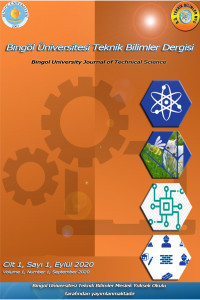Killerde Özel Bir Zamana Bağlı Deformasyon Türü: Ozmotik Sıkışma
Kil kimyasal etkileşimi üzerine yapılan birçok çalışma, kil numunelerin tamamen kimyasal etkisine maruz kalması sağlanarak yürütülmektedir. Ancak killerin kirleticilerle teması, sızma sürecinin de dahil olduğu zaman alan tedrici bir süreçtir. Örneğin tsunamilerle denizel kil olmasına rağmen yıllarca tuzlu su etkisinden uzak olan kil zeminlerin deniz suyuyla buluşması olası hale gelmektedir. Deniz suyu ile etkileşime geçen kil zeminler üzerinde inşa edilmiş yapılarda ilave oturmalar gerçekleşmesi olası hale gelmektedir. Bu nedenle kil zeminlerde görülebilen ozmotik sıkışma olgusunun iyi anlaşılması önem kazanmaktadır. Çalışma kapsamında killere özel bir davranış olan zamana bağlı deformasyonun özel bir türü olan ozmotik sıkışma konu alınmıştır. Kapsamlı bir konu olan kilin ozmotik etkiyle sıkışması, kilin su tutma mekanizmaları, yapı ve doku, zamana bağlı deformasyon davranışının esasları, killerde ozmotik etkinin temel mekanizmaları, ozmotik sıkışmanın tahmini ve ilgili teorinin kullanılabilirliği izah edilmeye çalışılmıştır.
Anahtar Kelimeler:
Ozmotik sıkışma, kil-kimyasal etkileşim, konsolidasyon, su adsorpsiyonu, Osmotic compression, clay-chemical interaction, consolidation, water adsorption
A Special Type of Time-Dependent Deformation in Clays: Osmotic Compression
Many studies on the chemical interaction of clay are carried out by ensuring that the clay samples are completely exposed to the chemical effect. However, the contact of clays with pollutants is a gradual process that takes time, including the infiltration process. For example, with tsunamis, it becomes possible for clay soils, which have been away from the effect of salt water for years, to meet with sea water, although it is marine clay. It becomes possible for additional settlements to occur in structures built on clay soils that interact with sea water.For this reason, it is important to understand well the osmotic compression phenomenon that can be seen in clay soils. Within the scope of the study, osmotic compression that is a special type of time-dependent deformation, which is a behavior specific to clays, is discussed. It has been tried to explain the osmotic compression of clay, which is a comprehensive subject, the water retention mechanisms of the clay, the structure and fabric, the principles of time-dependent deformation behavior, the basic mechanisms of the osmotic effect in clays, the estimation of osmotic compression and the usability of the related theory.
___
- Das BM. Advanced Soil Mechanics (1983). Mc-GrawHill, New York 1983.
- Holtz RD, Kovacs WD, Sheahan TC. An Introdution to Geotechnical Engineering. 2nd ed. Pearson Education Inc.; 2010.
- Mitchell JK, Soga K. Fundamentals of soil Behavior. John Wiley& Sons, Hoboken, New Jersey, USA 2005.
- Ghosh P. Chemical Engineering - Interfacial Engineering . Intermolecular and Surface Forces 2012. http://nptel.ac.in/courses/103103033/ (accessed October 12, 2018).
- Koper GJM. An Introduction to Interfacial Engineering. VSSD Delft; 2007.
- di Maio C. Exposure of bentonite to salt solution: Osmotic and mechanical effects. Geotechnique 1996;46:695–707. https://doi.org/10.1680/geot.1996.46.4.695.
- Calvello M, Lasco M, Vassallo R, di Maio C. Compressibility and residual shear strength of smectitic clays: influence of pore aqueous solutions and organic solvents 2005.
- Jang J, Cao SC, Stern LA, Jung J, Waite WF. Impact of Pore Fluid Chemistry on Fine‐Grained Sediment Fabric and Compressibility. J Geophys Res Solid Earth 2018;123:5495–514.
- Terzaghi K, Peck RB, Mesri G. Soil mechanics in engineering practice. John Wiley & Sons; 1996.
- Barbour SL. Osmotic Flow and Volume Change in Clay Soils. Dissertation. University of Saskatchewan, 1986.
- Bolt GH. Physico-Chemical Analysis of the Compressibility of Pure Clays. Géotechnique 1956;6:86–93. https://doi.org/10.1680/geot.1956.6.2.86.
- Staverman AJ. The theory of measurement of osmotic pressure. Recueil Des Travaux Chimiques Des Pays-Bas 1951;70:344–52. https://doi.org/https://doi.org/10.1002/recl.19510700409.
- Barbour SL, Fredlund DG. Mechanisms of osmotic flow and volume change in clay soils. Canadian Geotechnical Journal 1989;26:551–62.
- Thyagaraj T, Rao SM. Osmotic swelling and osmotic consolidation behaviour of compacted expansive clay. Geotechnical and Geological Engineering 2013;31:435–45.
- Nguyen XP, Cui YJ, Tang AM, Deng YF, Li XL, Wouters L. Effects of pore water chemical composition on the hydro-mechanical behavior of natural stiff clays. Eng Geol 2013;166:52–64. https://doi.org/10.1016/j.enggeo.2013.08.009.
- Kaczmarek M, Hueckel T. Chemo-mechanical consolidation of clays: analytical solutions for a linearized one-dimensional problem. Transp Porous Media 1998;32:49–74.
- Zhang T, Deng Y, Zhang D, Liu S. Preliminary Study of Pore Water Salinity Effects on the Swelling Behavior of Ca-Bentonite. Soil Behavior and Geomechanics, 2014, p. 54–64. https://doi.org/doi:10.1061/9780784413388.006.
- Zhang T, Wang S. Explanation of the influence of sodium chloride solution on volume deformation and permeability of normally consolidated clays. Materials 2019;12:1671.
- Rao SM, Thyagaraj T. Swell–compression behaviour of compacted clays under chemical gradients. Canadian Geotechnical Journal 2007;44:520–32.
- Rao SM, Thyagaraj T, Thomas HR. Swelling of compacted clay under osmotic gradients. Geotechnique 2006;56:707–13.
- Yang D, Yan R, Ma T, Wei C. Compressive behavior of kaolinitic clay under chemo-mechanical loadings. Acta Geotech 2023;18:77–94. https://doi.org/10.1007/s11440-022-01554-0.
- Scelsi G, Della Vecchia G, Musso G. An Elasto-Plastic Framework for the Chemo-Mechanical Behavior of Low to Medium Activity Clays. In: Barla M, Di Donna A, Sterpi D, editors. Challenges and Innovations in Geomechanics, Cham: Springer International Publishing; 2021, p. 648–55.
- Pubudu J, Buddhima I, Ana H. Influence of Salinity-Based Osmotic Suction on the Shear Strength of a Compacted Clay. International Journal of Geomechanics 2021;21:04021041. https://doi.org/10.1061/(ASCE)GM.1943-5622.0001988.
- Yayın Aralığı: Yılda 2 Sayı
- Başlangıç: 2020
- Yayıncı: Bingöl Üniversitesi
